Now let’s look at the
Mini / Kei Campers
This kei class, the mini campers, is the fourth main category of camper cars in Japan, and creativity runs wild here. Look at this Suzuki Every van conversion:
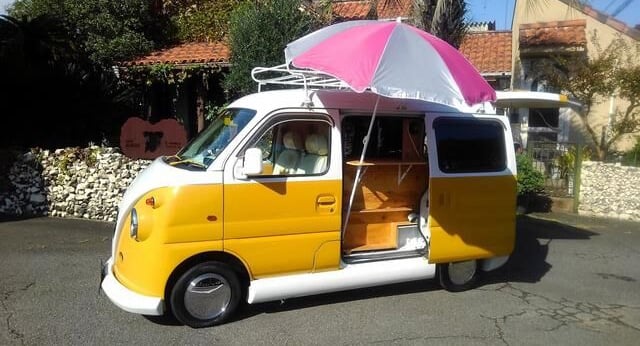
or this Suzuki Carry truck conversion:

And I’ve seen kei camper conversions even wilder than these.
Now, on a technical point, these kei-based campers are often no longer “Kei” or light vehicles under Japanese law. They sometimes have engines larger than 660cc, for obvious reasons, and that, and their extended bodies, put them beyond the small engine size and small exterior dimensions mandated by the regulations for true Japanese kei vehicles. But they share their basic chassis and cabs with kei trucks and kei vans so, in the end, they are very small, light, easy to park and maneuver, get terrific gas mileage, and have lots of the camper features that you want.
If you want to import a mini camper from Japan you can often get one that has a small fridge (the Carry truck above has a sink!), and there will be a storage compartment where you can keep a portable gas stove. (The advantage of a portable stove over one fixed to the vehicle is that you can always take the stove and its gas bottle out and set it up outside the camper; it’s safer, actually, and you can fry up your favorite spicy, smelly food and not worry about stinking up the camper interior.)
What are the downsides of a Japanese mini camper van? Well, if it’s got the 660cc engine, it may not be the best choice for long distance, high speed cruising and, in terms of accommodation, it’s really only for two adults. In addition, you’ll likely only get two belted seats. But, depending on the interior layout, you may have a decently comfortable sleeping area for the two of you.
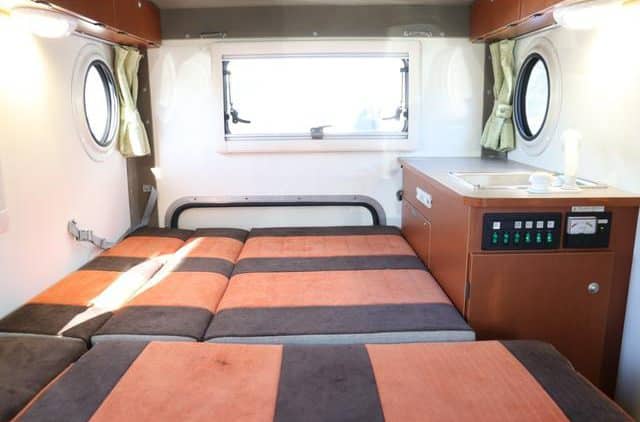
So just as I am always singing the praises of the whole kei class of Japanese vehicles, especially the kei sports cars which I’ve written about here
and here,
as small, but highly capable little units, I also think that the kei chassis based campers are just delightful, and, for their small size, they give you a lot. You get a lot of sporting fun in the case of the kei sports cars, and you get a lot of camper joy in the case of the kei-based campers.
Let’s bring our discussion about importing a used Japanese camper from Japan to a nice leisurely halt for just a moment while we talk a bit about importing from Japan a second hand camper of non-Japanese make or European JDM. Let’s go right to the icon of icons of camper vans, the one that started the craze in the first place, the one that became and remains the all time classic (and very sought after and practical) camper van, the Volkswagen camper, the Type Two.
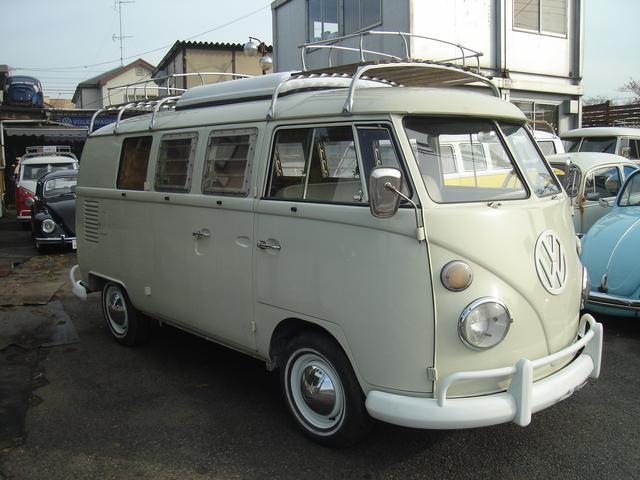
Importing a VW camper from Japan to Germany or another country in Europe may sound counter-intuitive, but it’s not at all. I have seen some really, really nice units here in Japan. Around the corner on my street there’s a newly retired couple whose son is now the proud and loving owner of a beautiful VW Type II Camper. First series, guys! First Series, like the one above. I was taking the dog for a walk when I first saw this clean and loved machine. I just came to a stop and looked longingly at that van camper. So warm those old VWs were. And it even smelled like the old Volksies used to; that special VW smell which is kind of a mix of gasoline, hot machine steel, and the whiff of a touch of oil or grease burned off from the old air-cooled engine. That’s the classic VW smell. And it took me back, way back, to my dad’s VW Type Twos. He had two of them, both second series like this one:
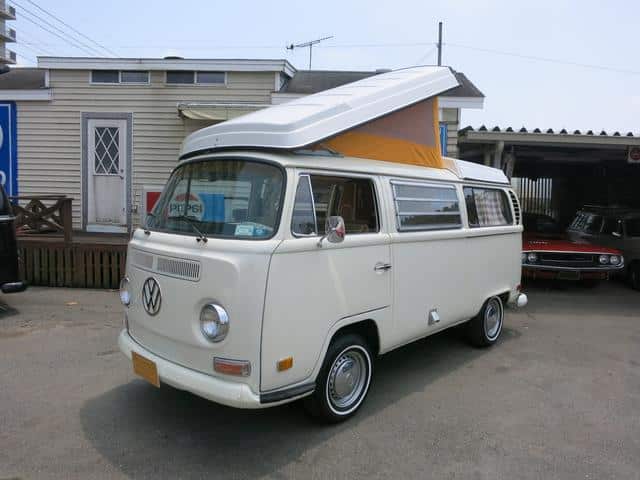
The first was a red camper and the second a lime green one. Both had the Westphalia factory pop top which gave a sleeping bunk above the main body. Both had a small fridge (primarily for beers for my dad and his friends), both had the center table and rear bunk (in the older one the table was fixed and was always in the way), only the second one had the stove (which we never used).
As a family, we never went on any super-long journeys in those VW campers, although my dad himself drove across Canada once in the red one. He said that going across the prairies, Manitoba, Saskatchewan, and Alberta, was spectacular, with this ruler-straight highway shooting out in front of the van for miles and endless miles. “You could see the curve of the sky,” he told us, “But the wind could come and blow the old van right off the road. And because it was so straight, you’d just start to go faster and faster. I never thought the old VW could go that fast. Must have had a tail wind.”
And, as anyone who has driven a VW Type Two knows, the big front windshield and the high-set seating position of those vans gives a great driver and front passenger view, so you really see the beauty and glory of the land you’re passing through on your camper journeys.
A point my father made about those two VWs is one that I should pass on to anyone here who is thinking of buying a second hand VW camper. Our first one, the red one, was a manual (four-speed, of course) and the second one, the green one, was an automatic. The VW camper does not have a big engine, and the older automatic transmissions were power suckers. An old-style automatic trans could take anywhere from ten to fifteen percent of the engine power just to operate the trans. With the VW Type two, even the newer, second series ones (the first series were not offered with an automatic, but correct me if I’m wrong), power is at a premium; so maybe it’s best to avoid the auto box on these and stick to the manual transmission. It’s stronger, too.
There are many super nice VW camper vans that come up for sale in Japan now and, like nearly all foreign cars in Japan, they are treasured, loved and maintained. You’re getting camper features like stove and fridge, and even, possibly, a small sink; sleeping accommodation for two adults and two kids (depending on interior layout and whether or not you have an extended roof, pop top or lean to) and you’re getting a camper van that has been treated like a classic.

Like I say, we never used our old VW Type II campers for long journeys, but the best was going to the zoo in Toronto or out to African Lion Safari in Cambridge, Ontario, and then, after seeing the animals, having lunch in our camper van at the edge of the parking lot. We kids were in and out, out and in; we sometimes sat properly at the little table (the one that wouldn’t fold down), we were sometimes out on the grass. If it was too sunny, or too cool, we’d enjoy the shade or warmth inside the van.
It all just brings back to me how fun and flexible camper vans are. Sure, you don’t get all the features of the proper motor home or full on van conversion, but even a partially converted camper van is a joy to have. And an especially important point about camper vans vs motor homes is that the van is easier to park in normal-sized parking spaces, like at the edge of the Safari Park parking area.
And this brings me back to another advantage of the Japanese campers and motor homes: they are basically small. Certainly smaller than one of those “prairie schooners” like the classic Winnebago:
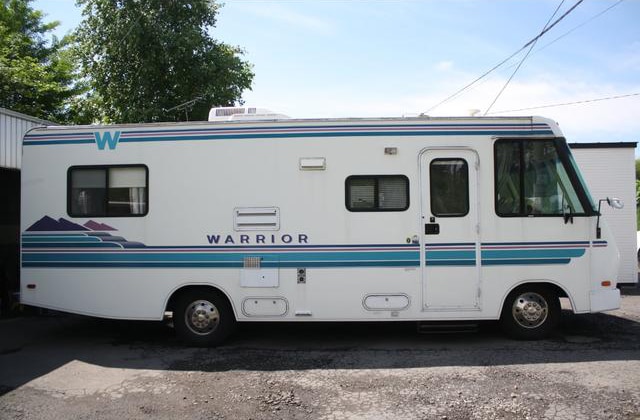
Japanese campers have tight exterior dimensions, although, as we’ve seen, they are packing a lot of good camper features into that small package.
The compact packaging of the majority of your Japanese campers, be they motor homes, full on van conversions or more modest, budget conversions; whether they be little kei truck-based mini campers, or even a converted small bus like a Rosa, the relatively small exterior dimensions give you more of what campers are all about: Freedom.
The freedom to up sticks if you don’t like the view or there’s too many bugs (of the insectoid or humanoid type). The freedom to change your plans and not worry, too much, about reservations. The freedom to go where you want to go and be left alone otherwise.
Now, if your camper is a huge thing, then there are just so many places that you can’t go, can’t stop, can’t even turn around. A big vehicle can be such a nightmare. In my twenties I drove big trucks (dumps, mixers, and roll-offs) in an urban area, so, believe me, I know the nightmare of the too big vehicle in the too small spot. It’ll ruin your day and it can certainly make your motoring holiday less, much less, relaxing. Buy a Japanese camper that’s smaller and has a tight turning circle and a fridge and you can enjoy your end-of-the-day beer in peace and in the confidence that you can get back out of wherever you are camping at the moment.
And, speaking of the moment, let me tell you something that sports cars and camper vans and motor homes all have in common. Speed? No, don’t be silly. Handling? You’re kidding me. Braking? Dream on. No, it’s the time to buy second hand that is the same with all these vehicles.
The summer comes to an end, fall passes and winter comes on. Is winter the time for me to put the top down on my roadster and head out into the beautiful hills and winding roads? No. It’s too cold. Winter is when many people who have enjoyed sports cars, but want to move on to something else, will put their cars up for sale. Winter is the time to get a good deal on a used sports car.
Same with secondhand campers and motor homes. Winter in the best season to buy one. Prices go down. Sellers are more willing to negotiate.
So, if you are seriously thinking of buying and importing a secondhand camper van or motor home from Japan, drop us a line at Japan Car Direct now (November, 2019 at the time of writing) and we’ll help you find what you are looking for in the used camper market. Then you’ll have the anticipation of your coming camper to keep you warm this winter.


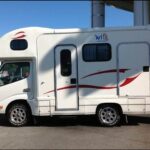
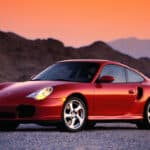




Hi Mathew, We are looking to come to the UK in 2023 and are interested to buy a small camper as an import from Japan. we are cash buyers. The Kei campers maybe what we are after. We would pay you to register it etc and we would resel lit thru you after 6 months if you are interested
Hello John! We are based in Japan. We will be able to source and export a camper to you. However, registration and resale in the UK would be up to you. Please contact me at [email protected] to discuss the export process. Thank you!